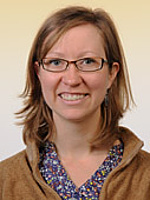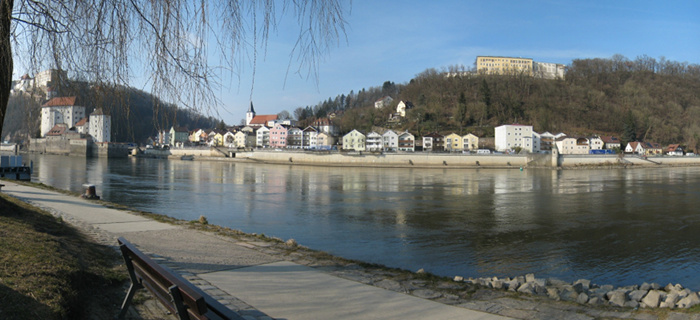
Pedal-powered conference: making tracks to the European Geosciences Union General Assembly
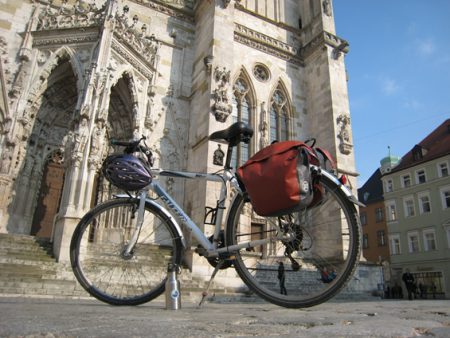
The idea was simple: combine a bicycle-touring vacation with alternative transportation to a conference. The European Geosciences Union (EGU) General Assembly took place in Vienna, Austria this year from April 7-12. The beautiful blue Danube River starts in the Black Forest, which is near our current home in southwestern Germany, and passes through Vienna as it winds its way to the Black Sea. A designated bike route traces the river through Germany and Austria, attracting hundreds of thousands of riders per year, mostly in the summer months. What better way to explore Bavaria and Austria, get some exercise and time away from the lab bench, and power our own way to the conference?
We headed off on March 31 with fingers crossed (or “thumbs pressed” as the equivalent German expression translates) for good weather. We chose to start in Ulm rather than at the source of the river in order to make it to Vienna in time for the conference in the eight days we had available. As the train sped toward Ulm, snow swirled around outside. We spent most of that first half-day on bicycles bouncing through mud-filled potholes and arrived to our hotel, the first guests of the season, with loaded bicycles and rain gear splattered in mud.
Perhaps the snow, mud and poor trails we encountered on the first day were necessary to calibrate our expectations for a spring expedition. Average daily temperatures reached only 3°C, the afternoons were windy, and the sun shone only briefly each day. However, we rode through very little subsequent precipitation, and trail conditions steadily improved. Each day in Germany was punctuated by medieval Bavarian townscapes blending one into another, separated by still-dormant agricultural fields, awaiting the arrival of spring. All the pedaling justified our indulgence in the German tradition of afternoon coffee and cake, almost a necessary stop to warm up frozen fingers and toes. Every night we slept well, bellies full of schnitzel and beer, glad to be tucked in cozy guesthouses and out of the wind for a few hours.
Passau, on the eastern edge of Bavaria, was the inflection point of our journey. Shortly after this town, where three rivers confluence, we concluded our 395 km crossing of Bavaria and ventured into Austria. The dialect changed and the floodplain funneled into forested valleys. We passed through vowel-deficient towns like Ybbs and Tulln that were still in winter hibernation, but the natural beauty of the route and the increase in the number of guesthouses as compared to Germany testified to this section of the Danube being the most popular bicycle route in Europe. This early in the season, though, we had the route mostly to ourselves, seeing other pairs of through-riders only about every other day. Coming into the Wachau Valley, within 80 km of Vienna, we encountered more riders out enjoying the scenery of this sunny wine-growing valley, which is also a UNESCO World Heritage Site.
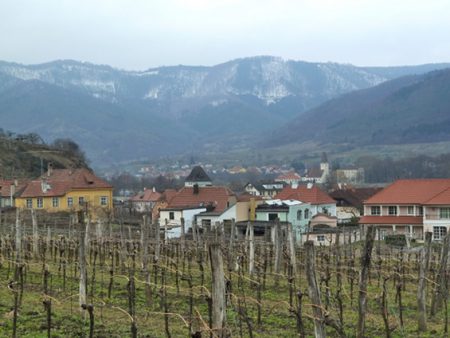
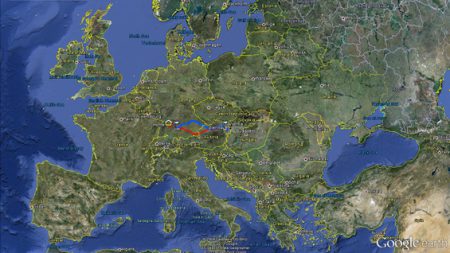
We rolled into Vienna on April 7, just hours before the EGU welcome event. As I related our journey to colleagues, the most common question was, “Are you riding back home?” Sore muscles and joints, bicycles needing repair and a depleted bank account validated our decision to purchase train tickets for the return journey.
As a geoscientist, the trip made me reflect on how the CO2 output of our pedal-powered trip compared to conventional travel. Could we justify our journey as a vacation and a lower carbon conference travel option? I set to work using online calculators to generate a back-of-the-envelope estimate.[1] The lowest emission transportation option for a round trip between our home and Vienna is the train, releasing an estimated 0.32 tons of CO2. A round-trip flight, plus local transit to and from the airport emits 0.48 tons of CO2. Our journey, 734 km of riding, burned primarily calories, but required 7 nights in hotels beyond the accommodation we needed at the conference. Hotel stays during our ride generated 0.5 tons CO2, much more than the 0.04 tons our household produces in the same time interval. Adding in a return train trip, our round-trip CO2 emission was 0.66 tons.
By linking our vacation to the conference, we did at least eliminate the emissions of extra travel if the two trips were taken separately. Of course, pedaling to the conference was only feasible because we currently live in Europe. With Goldschmidt coming up in Florence, Italy this August, I considered briefly whether to again take advantage of our home-base in Europe and make the trip by bicycle. My analysis suggested carbon emission is an equivocal factor in the decision to ride, but there is one major geological factor. The Alps stand between Germany and Italy. My muscles and joints hurt just imagining that climb. I will be booking a flight to Florence this week.
[1] The Carbon Neutral Company. (n.d.). CarbonNeutral® commute. Retrieved from: http://www.carbonneutralcalculator.com, and Conservation International. (n.d.). Carbon Calculator. Retrieved from: http://www.conservation.org
About the Author
Elizabeth D. Swanner is a geomicrobiologist and geochemist interested in the co-evolution of life and Earth’s surface environment. Her current work focuses on microbial pathways involved in the mineralization of redox-active transition metals and what their presence in the rock record tells us about the redox state of ancient aqueous environments. Betsy, as she is known to friends and colleagues, received her PhD from the University of Colorado, Boulder. She currently resides in southwestern Germany with her husband (and travel companion), and is a postdoctoral fellow at the University of Tübingen.
